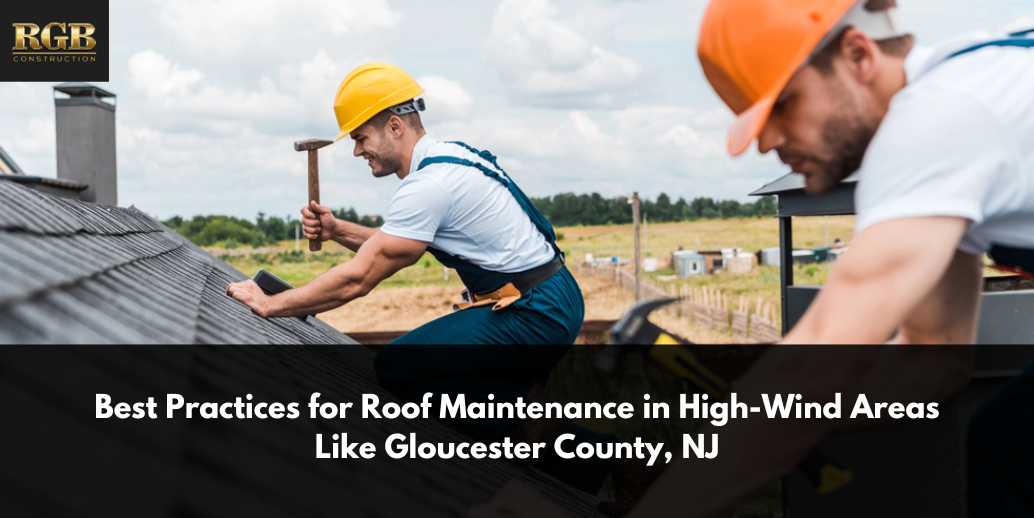Gloucester County, New Jersey is no stronger to high winds and severe weather patterns. Small tornados? Derecho winds? You have probably experienced them—or at least heard about it—and don’t want to go through such a thing twice. After all, high winds can cause significant damage to roofs, leading to costly repairs and jeopardizing the safety of your home. Implementing best practices for roof maintenance can help protect your property and ensure its longevity. Here are some essential tips for maintaining your roof in high-wind areas like Gloucester County.
Key Takeaways
- Gloucester County, NJ is known for experiencing high winds throughout the year, and those winds can be damaging.
- Conduct inspections at least twice a year and after major storms to detect issues early and prevent costly damage.
- Regularly trim branches near your roof to minimize damage from falling debris during high winds and reduce gutter clogging.
- Consider adding hurricane straps and vents to secure your roof and improve ventilation, reducing wind pressure.
- Ensure your homeowner’s insurance covers wind-related roof damage to protect your investment in case of unexpected events.
Conduct Regular Inspections
Regular roof inspections are vital for identifying and addressing potential issues before they become severe problems. It is recommended to conduct inspections at least twice a year, preferably in the spring and fall. Additionally, inspect your roof after any major storm or high-wind event. Look for signs of damage, such as missing or damaged shingles, loose flashing, and debris accumulation. Professional inspections by a qualified roofing contractor, like RGB Construction, can provide a thorough assessment and identify issues that may not be visible to the untrained eye.
Secure Loose Shingles and Flashing
High winds can easily lift and dislodge loose shingles and flashing, creating entry points for water and further damage. During inspections, check for any loose or missing shingles and secure them promptly. Use roofing cement or nails to fasten loose shingles and ensure they are properly sealed. Inspect flashing around chimneys, vents, and other roof penetrations to ensure they are securely in place. Reattach or replace any loose or damaged flashing to prevent water infiltration.
Trim Overhanging Branches
Overhanging tree branches can pose a significant threat to your roof during high winds. Branches can break off and fall onto your roof, causing damage to shingles, gutters, and other components. Regularly trim any branches that hang over your roof to minimize this risk. Keep trees well-maintained and ensure that branches are at least six feet away from your roof. This not only protects your roof but also reduces the amount of debris that can accumulate and clog gutters.
Maintain Gutters and Downspouts
Properly functioning gutters and downspouts are essential for directing water away from your roof and preventing water damage. High winds can blow debris such as leaves, twigs, and dirt into your gutters, causing blockages. Regularly clean your gutters and downspouts to ensure they are free of debris and can effectively channel water away from your roof. Consider installing gutter guards to minimize debris accumulation and reduce the frequency of cleaning.
Reinforce Roofing Materials
In high-wind areas, reinforcing your roofing materials can provide added protection and durability. Consider using impact-resistant shingles designed to withstand high winds and severe weather. These shingles are typically made from stronger materials and have a higher wind rating. Additionally, ensure that your roof’s underlayment is properly installed and in good condition. A high-quality underlayment can act as an additional barrier against wind and water infiltration.
Install Wind-Resistant Features
Certain features can enhance your roof’s resistance to high winds. For example, installing hurricane straps or clips can help secure your roof to the structure of your home, reducing the risk of it lifting during strong winds. Ridge vents and soffit vents can improve ventilation and reduce pressure on your roof during high-wind events. Consult with a professional roofing contractor to determine the best wind-resistant features for your specific roof type and structure.
Address Roofing Issues Promptly
Promptly addressing any roof repairs is crucial for preventing minor issues from escalating into major problems. If you notice any signs of damage, such as leaks, cracked shingles, or damaged flashing, contact a professional roofing contractor immediately. Delaying repairs can lead to further damage and increased repair costs. Regular maintenance and timely repairs can extend the lifespan of your roof and protect your home from high-wind damage.
Maintain Adequate Insurance Coverage
Despite taking all the necessary precautions, high winds can still cause unexpected damage to your roof. Ensure that your homeowner’s insurance policy provides adequate coverage for wind-related roof damage. Review your policy regularly and update it as needed to reflect the current value of your home and roof. Having sufficient insurance coverage can provide peace of mind and financial protection in the event of significant wind damage.
Contact a Roofing Contractor in Gloucester County, NJ Today
Roof maintenance is key when you live in a high-wind area like Gloucester County, NJ. Make sure you are regularly conducting inspections, securing loose materials, trimming overhanging branches, maintaining gutters, reinforcing roofing materials, installing wind-resistant features, addressing repairs promptly, and maintaining adequate insurance coverage are all critical practices for ensuring the longevity and durability of your roof. At RGB Construction, our exceptional team does roofing maintenance and repairs for high-wind areas and so much more. Contact us today to schedule an inspection and keep your roof in top condition, no matter the weather.







